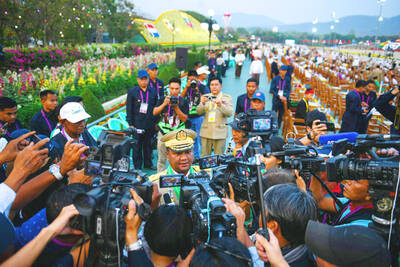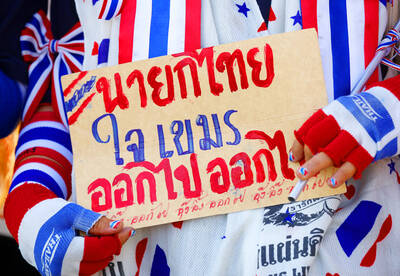A spate of violent attacks on Indians in Australia is straining bilateral relations and costing Australian universities lucrative foreign student revenue. There is sharp debate, however, about whether racism is at the root of the problem.
Some Indian officials and media have been quick to blame racism for the highly publicized beatings, robberies and murders, mostly in Melbourne, Australia’s second largest city and one proud of its cultural diversity. India has demanded swift action to protect its citizens.
Australia, which regards itself as a multicultural success story, has staunchly defended its reputation for welcoming foreigners — including students whose tuition fees are worth A$12 billion (US$11 billion) a year to a burgeoning export industry in education.
Discerning the truth, amid the back and forth, has proven difficult.
The controversy comes amid explosive growth in the foreign student population in Australia. The Indians have grown the fastest, from 2,700 in 2002 to 91,400 last year. Overall, foreign students rose from 150,000 to almost 400,000 during the same period.
Australian universities expect Indian enrollment to plummet 30 percent this year, in part because of safety fears.
No doubt there is racism in Australia, as in virtually every society. Researchers have found that one in 10 adults here could be described as racist, a proportion that is not negligible, University of Western Sydney geographer Kevin Dunn said.
“It’s good that they’re a minority of people, but what’s bad is if we deny that that’s out there, and secondly, that we don’t do anything about it,” he said. “My concern is the Indians are right in saying that on those latter two points, we’ve got a problem.”
To what degree racism is behind the attacks is another question.
Melbourne-based Monash University social scientist Andrew Markus, whose own research supports Dunn’s findings, said factors other than anti-Indian sentiment also put the students at risk.
For example, they often stay in inexpensive housing in crime-ridden neighborhoods and work night shifts driving taxis or staffing takeout food restaurants, he said.
Pino Migliorino, chairman of the Federation of Ethnic Communities’ Councils of Australia, agreed the government should do more to combat racism.
But he is not convinced that the violence against Indians is racially motivated, or that Indians face more racism than other groups.
Indian students are a particularly articulate group with access to established Indian media in Melbourne and an ability to attract international attention, he said.
“A group of Sudanese kids might be harassing, they might be harassed, they might have been in a fight, but whether that develops into a major incident which has repercussions internationally, I would doubt it,” Migliorino said.
Gautam Gupta, a spokesman for the Federation of Indian Students of Australia, said foreign students who do not come from democratic societies are reluctant to stand up for their rights.
“Indians are used to freedom of speech, we are used to raising our voices to get things done,” said Gupta, whose group led street marches in Melbourne last year against racial violence.
Gupta said that Indian students have been campaigning against violence for eight years. However, the issue gathered steam following the near-fatal stabbing of an Indian student at a party in Melbourne in September and the stabbing death of a 21-year-old Indian graduate last month, also in Melbourne.
The Australian government and police have played down the racism angle, saying there is no hard evidence that Indians are being disproportionately targeted.
This week, Victoria state Premier John Brumby accused Indian media and some government representatives of lacking objectivity.
He spoke after police charged an Indian man who had claimed he was attacked in Melbourne with faking the story to back a false insurance claim, and suspects in the murder of another Indian man were revealed to be Indian themselves.
“I hope that there is some balance to the debate, some balance to the reporting in India and certainly to date that balance hasn’t been there,” Brumby said.

Eleven people, including a former minister, were arrested in Serbia on Friday over a train station disaster in which 16 people died. The concrete canopy of the newly renovated station in the northern city of Novi Sad collapsed on Nov. 1, 2024 in a disaster widely blamed on corruption and poor oversight. It sparked a wave of student-led protests and led to the resignation of then-Serbian prime minister Milos Vucevic and the fall of his government. The public prosecutor’s office in Novi Sad opened an investigation into the accident and deaths. In February, the public prosecutor’s office for organized crime opened another probe into

RISING RACISM: A Japanese group called on China to assure safety in the country, while the Chinese embassy in Tokyo urged action against a ‘surge in xenophobia’ A Japanese woman living in China was attacked and injured by a man in a subway station in Suzhou, China, Japanese media said, hours after two Chinese men were seriously injured in violence in Tokyo. The attacks on Thursday raised concern about xenophobic sentiment in China and Japan that have been blamed for assaults in both countries. It was the third attack involving Japanese living in China since last year. In the two previous cases in China, Chinese authorities have insisted they were isolated incidents. Japanese broadcaster NHK did not identify the woman injured in Suzhou by name, but, citing the Japanese

RESTRUCTURE: Myanmar’s military has ended emergency rule and announced plans for elections in December, but critics said the move aims to entrench junta control Myanmar’s military government announced on Thursday that it was ending the state of emergency declared after it seized power in 2021 and would restructure administrative bodies to prepare for the new election at the end of the year. However, the polls planned for an unspecified date in December face serious obstacles, including a civil war raging over most of the country and pledges by opponents of the military rule to derail the election because they believe it can be neither free nor fair. Under the restructuring, Myanmar’s junta chief Min Aung Hlaing is giving up two posts, but would stay at the

YELLOW SHIRTS: Many protesters were associated with pro-royalist groups that had previously supported the ouster of Paetongtarn’s father, Thaksin, in 2006 Protesters rallied on Saturday in the Thai capital to demand the resignation of court-suspended Thai Prime Minister Paetongtarn Shinawatra and in support of the armed forces following a violent border dispute with Cambodia that killed more than three dozen people and displaced more than 260,000. Gathered at Bangkok’s Victory Monument despite soaring temperatures, many sang patriotic songs and listened to speeches denouncing Paetongtarn and her father, former Thai prime minister Thaksin Shinawatra, and voiced their backing of the country’s army, which has always retained substantial power in the Southeast Asian country. Police said there were about 2,000 protesters by mid-afternoon, although